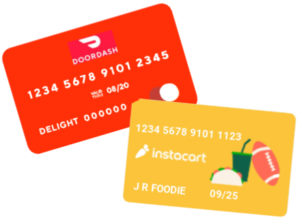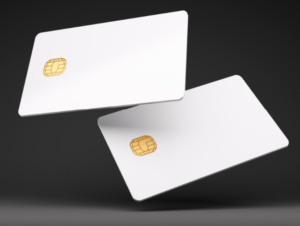By Jeff Domansky, April 9, 2021
Grocery delivery app Instacart and restaurant delivery firm DoorDash are both planning to issue credit cards soon.

Two questions come to mind for both businesses and consumers. First, do we need more branded credit cards? Second, what’s the ROI of a branded credit card for businesses and merchants?
The Wall Street Journal reports Instacart chose JPMorgan Chase to issue its new credit card, available early next year. Among the anticipated features are 5% cashback rewards, a powerful loyalty magnet for merchants. Instacart added deliveries of products from Staples, Bed and Beyond, and other merchants in the past year to grow its business.
DoorDash reportedly received card-issuing pitches from more than ten banks, including JPMorgan Chase. Banks hope to broaden their client base post-Covid with success stories like these two delivery services. Also among the bidders is a partnership of fintech firms Deserve and Marqeta.
More co-branded credit cards?
More to the point, do consumers want more co-branded credit cards? US News research found nearly 43% of users prefer general rewards cards rather than co-branded credit cards, while 36% said they like a mix. Two-thirds of consumers said they did not use a rewards credit card.

The most popular features with users were cashback rewards (12.8%), no annual fee (8.7%), specific brand loyalty perks and rewards (4.5%), cardholder benefits (3.9%), introductory APR (2%), and a signup bonus (1.8%).
The rewards redeemed by consumers surveyed were also telling, with 42.2% saying they redeemed cashback rewards and 20.8% redeemed travel rewards in the previous year.
While 34.6% said there were no features they disliked, the least popular features included annual fees (23.5%), high APR (16.5%), expiring rewards (11.2%), redemption limits (7.6%), earning caps (3.7%), and high signup spending levels required to earn rewards (2.9%).
ROI on rewards credit cards
There is a payback for merchants with credit card rewards programs. Only 20.3% of cardholders earned more than $1,000 in rewards annually. Rewards are also heavily discounted by partners and providers, so card issuers and merchants’ actual cost is much lower than it seems.
Market research firm Packaged Facts estimates that co-branded credit cards generated $990 billion in purchase value in 2018. Competition is enormous for new entrants with co-branded credit cards. “Costco’s AnyWhere Visa performance has helped lift the entire segment, surpassing $100 billion in purchase value in 2018 while helping issuing partner Citibank build loans,” the research firm said. “At American Airlines alone, some $3.1 billion in program miles were earned in 2018, while $3.4 billion in miles were redeemed.”

JPMorgan Chase provides Amazon and Starbucks with co-branded credit cards. Apple, Walmart, and Uber are also popular branded credit cards. The business benefits are clear:
- revenue sharing: a hefty incentive with issuers earning an average of 2% of each transaction which leaves from for revenue sharing
- loyalty: The Nielsen Company reports “67% of consumers shop more frequently and spend more at retailers with loyalty programs”
- data: spending data is hugely valuable for marketing, targeting, product development, and competitive intelligence
- branding: “We found that the best cards offer consumers between $250 and $700 in rewards per year and serve to promote your brand further, sometimes even before anyone even uses the card,” said Value Penguin’s Maxime Rieman.
Rewards race continues
DoorDash and other food delivery competitors like GrubHub, UberEats, and Skip the Dishes are exploring or rapidly building loyalty programs in the hopes of retaining customers after Covid subsides.
Features under consideration include accelerated offers, special promotions, VIP event access, and curated experiences with merchants. DoorDash hopes customers will join its monthly $10 subscription delivery service by offering expanded rewards.
We’ve answered the key questions. There is room for new, competitive, full-featured branded credit cards. And there is a return on investment for businesses that co-brand their credit card right.
The challenge is for issuers and merchants to find the sweet spot of features, costs, and ROI.
More credit card and loyalty stories:
Petal aims to be a credit card for credit-blemished customers
E-gift cards see 820% jump in malicious attacks in 2020
Recycled plastic payment cards reduce ocean waste








LET’S CONNECT